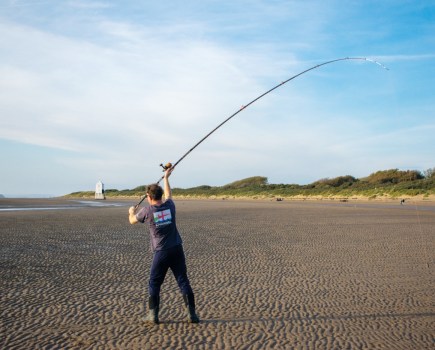John Holden reveals why your favourite beachcaster could be wrong for you
Every casting style has a characteristic shape. In the classic wide-swing pendulum style, rod tip and sinker accelerate on a long and deeply rounded path that starts with the rod tip high. A relatively shorter path, where the power starts building when the rod tip is low, characterises ground casts and the flatter pendulum styles.
The aim is the same: to make rod and caster work efficiently and smoothly. Although some rod designs are fairly versatile, it always pays to match the rod to the style of casting as well as to the caster’s skill and power.
When the sinker peaks on its inswing in the big-swing pendulum method, it hovers for a moment high in the air. The power flow begins fairly slowly but forcefully enough to bring the sinker and rod tip down and around on to the right path, storing energy all the way. For easy swing control and smooth transition into the main cast, the rod tip should be fairly flexible to provide some cushioning.
Second Stage
Moving into the second stage of the cast, which is powered mainly by body rotation, the priority is to get a decent bend into the middle section of the rod. This stores energy in a similar fashion to drawing a catapult, and it also stiffens the rod into a firm lever. A goodly bend in the mid-section plus the resultant stiffness give the feeling that the rod and sinker are nicely behind you as you move into the final stage of the cast.
The blank’s curvature also effectively shortens the rod and thus makes the load easier to handle. In all, as the rotation phase ends, the caster is in the right position to make the arms work properly, and the rod feels nice and solid with the sinker following the tip on exactly the right path. That feeling triggers the final stage: whack the power in to send the rig high and far.
Rod Design
The rod design that excels with this style of casting falls between slow and medium-fast action, meaning that although the lower third of the rod may be very stiff the middle section is quite flexible, a trend that continues into the top section. In addition to being nicely matched to the casting style, rods like this are versatile when it comes to sinker choice, and according to their devotees they’re highly satisfying to fish with. As short as 11ft 6in may deliver all the performance you need for 150g-200g work. Few people can master more than 13ft 6in anyway. Within that span, it’s mainly a matter of choosing whichever length feels right.
But suppose your ground-casting mate picks up your beloved pendulum rod and says, “What’s this… some kind of bass rod? It’s too short and gutless. You ought to buy a proper rod. Try mine.” It looks good and sports a big-name sticker, so it must be brilliant. You give it the familiar big swing… and damn near break your back. What’s going on? More next time







